California Gold Quartz Specimen Natural Gold Nugget 13.9 Gram Gold In Quartz
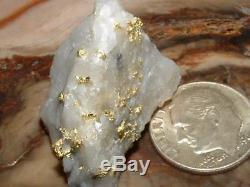
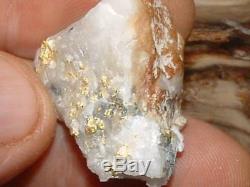
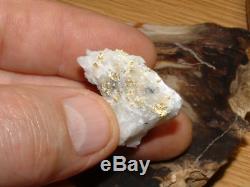
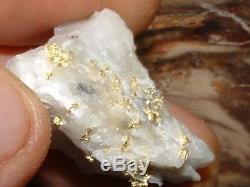
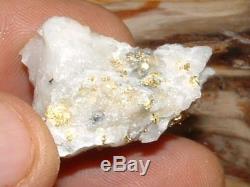
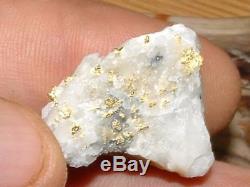
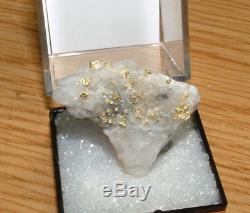


NATIVE GOLD QUARTZ SPECIMEN from the MOTHER LODE. R uler is 1/4 wide (6 mm). 10 cent coin is 17 mm in diameter. S pecimen weight: 13.9 G ram - 215 G rains. S ize: 30X22.2X21.1 mm. I f you've an eye for gold straight from the earth, check out this sparkling chunk of gold quartz from the Sierra Nevada Mtns. In form, the crystalline growth of the Au appears like growths of coral poking up out of the sea-floor. This rich, micro-mountable specimen will make a welcome addition to your collection.
The attached quartz is predominantly-white. Somewhat surprisingly, one face shows a colorful patina grading from orange to yellow. It's one of my favorite specimens and should spice up your collection of native gold minerals nicely.
B ack when I actively mined, nuggets would sometimes show up with host rock embedded or protruding from the gold. Searching further up-slope, it was common to see quartz outcroppings. The vein filling in these ore bodies would be very similar to the matrix in your nugget. Naturally, one began to wonder if this might be the same vein which shed your specimen. I could not begin to count how many times I've climbed up a slope with trusty rock hammer in hand and taken chip samples.
During my prospecting years, a couple of gold-bearing veins were located this way, but these were rare occurrences. Whether veins run horizontally, vertically, or pitch downward at an angle, the gold values found inside such ore bodies are seldom consistent and uniform in ore tenor. Because of the enormous cost, danger, and difficulty in developing a lode deposit, I preferred leaving lodes to the hard-rock miners. Assays, if commissioned, are rather expensive as well.
In pocket country, whenever a potential source of eroding placer gold is found in the form of an attractive vein system, it's advisable to take samples and detect the heck out of it. You might get lucky and discover a pocket or lens on a quartz vein that is still shedding-gold. Generally-speaking, placer was my focus, and no matter how disfigured, discolored, deformed, or impure a nugget might be, I never found a piece of gold I didn't like. It takes a lot of effort to find gold whether it's placer or a pocket, so there's really no such thing as an'ugly nugget'.Each one is beautiful in it's own way. I guarantee the gold growths here are a natural occurrence.
All my specimens show visible gold and are authentic gold quartz specimens. I don't paste'pounded gold' or spray gold-colored paint on barren rock. Refractory ores, which need to be heated and run through special processes to release the minute amount of gold locked up inside, aren't usually my thing. When I do sell sulphides, you'll be able to see gold associated with the pyrites. You won't need to crush and treat my rocks with cyanide solution to get at the gold. We're not dealing in micron gold. I deal in genuine high-grade, naturally-occurring gold quartz with visible gold, both as specimen and as jewelry-grade slab. Such rich rocks and lapidary rough are hard to find and expensive to obtain. I poured through old mining dumps for years looking at orange-yellow-rusty rock through a loupe, but I never found a piece with visible gold. Hydrothermal solutions carrying gold and silica crystallized into veins of gold quartz. This specimen comes from one of the many vein systems sourcing the immense placer deposits of the Sierra Nevada Mtns, the famed Mother Lode. 15.43 GRAINS = 1 GRAM. 31.103 GRAMS = 1 TROY OUNCE. 24 GRAINS = 1 PENNYWEIGHT (DWT). 20 DWT = 1 TROY OUNCE. 480 GRAINS = 1 TROY OUNCE. We leave no stones unturned insuring our customers get what they bargained for.If you're not satisfied with this item, contact me. One method used to mine desert gold is a device (some think of it as an instrument of torture) better known as a drywasher. Sometimes, these gold-separating gizmos are called an'air jig'. A bellows-type machine might be labelled a'puffer belly'. Other types of dry-washers don't'puff', however, they'blow'.
To use a dry-washer, first, you determine if the material you want to run is dry and loose enough to be efficiently processed. Even when it's completely dry, you wouldn't think hard-packed clay or caliche could be run through a drywasher, but surprisingly, once these consolidated sediments are broken up out of the pack, most of the bigger gold pieces can actually be separated from the dirt. Extremely wet ground poses a problem.
It needs to be spread out in the sun for drying. The acts of screening or running material through your drywasher will also help to accomplish the same purpose.Ideally, the rule is: the dryer, the better. It's not always a lost cause, however, when the ground seems too hard-packed or wet to run.
If a spot looks favorable, set your drywasher up and stabilize it. Then, start conveying the dirt, clay, sand, or gravel (by shovel or bucket) onto the screening section of your machine (the grizzly). Sediments classified by the grizzly drop into another section of the apparatus known as the'hopper'. Ideally, o nce the machine is activated, the down-sized material moves or feeds over a series of "riffles" in a concentrator tray.
This process varies only slightly from machine to machine. With regards to hand-built dry-washers, many I have seen were inherently-flawed in their design. When you see 5 evenly-spaced riffles 1/2 or 3/4 inch high built into a concentrator tray that is 2 feet long all set to run at a 45 degree angle, that is a recipe for gold loss. You may accidentally capture some coarser gold if present provided the ground is dry, but if your deposit contains mostly fine-grained particles of gold and lots of black sands, good luck, amigo/amigas. Anyway, it's always a good idea to check your tailings pile for losses using what you know to be an efficient processing method such as sluicing (with water) or even hand-panning (again, with water) some of the tailings material.
Honestly, my prospecting career, which began down in the desert near Tucson, relied upon one of the more inefficient mechanisms a person could use i. Thanks for checking out our digs. G old of E ldorado 1-14-13.
The item "CALIFORNIA GOLD QUARTZ SPECIMEN NATURAL GOLD NUGGET 13.9 GRAM GOLD IN QUARTZ" is in sale since Wednesday, September 26, 2018. This item is in the category "Collectibles\Rocks, Fossils & Minerals\Crystals & Mineral Specimens\Precious Metals". The seller is "egm947" and is located in Banks, Oregon. This item can be shipped worldwide.

